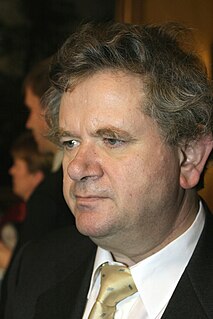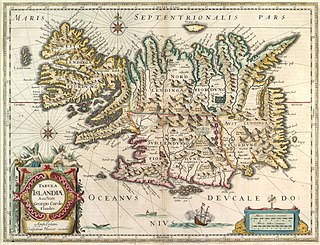 |
|---|
| This article is part of a series on the politics and government of Iceland |
| |
Parliamentary elections were held in Iceland on 10 September 1908, alongside a referendum on prohibition. [1]
 |
|---|
| This article is part of a series on the politics and government of Iceland |
| |
Parliamentary elections were held in Iceland on 10 September 1908, alongside a referendum on prohibition. [1]
The Althing was dissolved by King Frederick VIII in the early spring in order to elect a new parliament that would vote on a draft status law that would define the position of Iceland in the Danish realm. [2] The election campaign was one of the acrimonious in Icelandic political history due to the controversial nature of the draft. [2] The opposition was led by Skúli Thoroddsen, a member of the Independence Party. [3]
The 36 members of the Althing were elected from a mix of single-member and two-member constituencies. [4] The elections were the first to take place since changes to the electoral system in 1904; they were the first to be held using the secret ballot, [5] and also saw the three-round majoritarian system replaced by plurality voting as multiple rounds of voting on the same day were no longer possible. [4] The tax qualification for voting was also reduced, increasing the proportion of people able to vote to around 14% of the population, [4] up from 7,786 in 1903 to 11,726. [6]
Candidates opposed to the draft law won a landslide majority, whilst voter turnout was 72.4%, nearly 20% more than the 1903 elections. [6] As a result, the law was voted down in 1909, [2] resulting in the resignation of Minister for Iceland Hannes Hafstein. [3]

The Alþingi is the national parliament of Iceland. It is the oldest surviving parliament in the world. The Althing was founded in 930 at Þingvellir, situated approximately 45 kilometres (28 mi) east of what later became the country's capital, Reykjavík. Even after Iceland's union with Norway in 1262, the Althing still held its sessions at Þingvellir until 1800, when it was discontinued. It was restored in 1844 and moved to Reykjavík, where it has resided ever since. The present parliament building, the Alþingishús, was built in 1881, made of hewn Icelandic stone. The unicameral parliament has 63 members, and is elected every four years based on party-list proportional representation. The current speaker of the Althing is Steingrímur J. Sigfússon.

Hannes Þórður Pétursson Hafstein was an Icelandic politician and poet. In 1904 he became the first Icelander to be appointed to the Danish Cabinet as the Minister for Iceland in the Cabinet of Deuntzer and was – unlike the previous Minister for Iceland Peter Adler Alberti – responsible to the Icelandic Althing.

Parliamentary elections were held in Iceland on 20 April 1991. The Independence Party remained the largest party in the Lower House of the Althing, winning 17 of the 42 seats.
Early parliamentary elections were held in Iceland on 25 and 26 October 1959. Following the electoral reforms made after the June elections, the Independence Party won 16 of the 40 seats in the Lower House of the Althing.
Parliamentary elections were held in Iceland on 30 June 1974. The Independence Party remained the largest party in the Lower House of the Althing, winning 17 of the 40 seats. They formed a coalition with the Progressive Party and Independence Party leader Geir Hallgrímsson was elected Prime Minister.
Parliamentary elections were held in Iceland on 25 April 1987. The Independence Party remained the largest party in the Lower House of the Althing, winning 12 of the 42 seats.
A two-part referendum was held in Iceland between 20 and 23 May 1944. Voters were asked whether the Union with Denmark should be abolished and whether to adopt a new republican constitution. Both measures were approved, each with more than 98% in favour. Voter turnout was 98.4% overall, and 100% in two constituencies, Seyðisfirði and Vestur-Skaftafjellssýsla.

The Icelandic Independence movement was the collective effort made by Icelanders to achieve self-determination and independence from the Kingdom of Denmark throughout the 19th and early 20th century.
Elections for the Constituent Assembly were held in Denmark on 5 October 1848. Of the 158 seats in the Assembly, 114 were elected and 44 appointed by the King. An additional 31 candidates were to come from the Duchy of Schleswig but were not elected due to the First Schleswig War.
Parliamentary elections were held in Iceland on 21 October 1916. Voters elected all 26 seats in the Lower House of the Althing and eight of the fourteen seats in Upper House, the other six having been elected in August. The Home Rule Party emerged as the largest party in the Lower House of the Althing, winning eight of the 26 seats.
Parliamentary elections were held in Iceland on 5 August 1916, the first elections held after women's suffrage was introduced. Following reforms to the Althing the previous year, the six seats in the Upper House appointed by the monarch were abolished, and replaced with six elected seats. The seats were elected by proportional representation at the national level, using the D'Hondt method. The remaining eight seats were elected along with the Lower House in October.
Elections to the Upper House of the Althing were held in Iceland on 1 July 1926. Six seats were elected by proportional representation at the national level, using the D'Hondt method. The remaining eight seats were elected along with the Lower House.
Elections to the Upper House of the Althing were held in Iceland on 15 June 1930. Following reforms in 1915, the six seats in the Upper House appointed by the monarch were abolished, and replaced with six elected seats. The seats were elected by proportional representation at the national level, using the D'Hondt method. The remaining eight seats were elected along with the Lower House. This was the last election solely for the Upper House, as from 1934 onwards all Upper House members were elected together with the Lower House.
Parliamentary elections were held in Iceland on 15 November 1919. Voters elected all 26 seats in the Lower House of the Althing and eight of the fourteen seats in Upper House. The Home Rule Party remained the largest party in the Lower House, winning 10 of the 26 seats.
Parliamentary elections were held in Iceland on 27 October 1923. Voters elected all 28 seats in the Lower House of the Althing and eight of the fourteen seats in Upper House. The Citizens' Party, a loose collection of conservatives, emerged as the largest party in the Lower House, winning 16 of the 28 seats.
Parliamentary elections were held in Iceland on 9 July 1927. Voters elected all 28 seats in the Lower House of the Althing and eight of the fourteen seats in Upper House. The Progressive Party emerged as the largest party in the Lower House, winning 13 of the 28 seats.
Parliamentary elections were held in Iceland on 24 June 1934. They were the first held after reforms to the electoral system that increased the number of seats in the Lower House from 28 to 33 and ensured that all members of the Althing were elected at the same election. The Independence Party emerged as the largest party in the Lower House, winning 14 of the 33 seats.
Parliamentary elections were held in Iceland on 5 July 1942. Although the Independence Party won a plurality of votes, the Progressive Party remained as the largest party in the Lower House of the Althing, winning 14 of the 33 seats.
Early parliamentary elections were held in Iceland on 18 and 19 October 1942. They were held after reforms were made to the electoral system following the July elections. The Independence Party emerged as the largest party in the Lower House of the Althing, winning 13 of the 35 seats.
Parliamentary elections were held in Iceland in 1844. They were the first elections in the country's history.